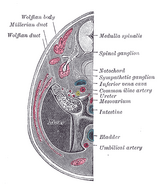Assessment |
Biopsychology |
Comparative |
Cognitive |
Developmental |
Language |
Individual differences |
Personality |
Philosophy |
Social |
Methods |
Statistics |
Clinical |
Educational |
Industrial |
Professional items |
World psychology |
Developmental Psychology: Cognitive development · Development of the self · Emotional development · Language development · Moral development · Perceptual development · Personality development · Psychosocial development · Social development · Developmental measures
The mesonephric duct (also known as Wolffian duct, archinephric duct, Leydig's duct and nephric duct) is a paired organ found in mammals including humans during embryogenesis.
It connects the primitive kidney Wolffian body (or mesonephros) to the cloaca and serves as the anlage for certain male reproductive organs.
Development[]
Wolffian duct (red) degenerates in females (middle image) and develops in males (bottom).
In both the male and the female the Wolffian duct develops into the trigone of urinary bladder, a part of the bladder wall. However, further development differentiates between the sexes in the development of the urinary and reproductive organs.
Male development[]
In a male, it develops into a system of connected organs between the efferent ducts of the testis and the prostate, namely the epididymis, the vas deferens, and the seminal vesicle. The prostate forms from the urogenital sinus and the efferent ducts form from the mesonephric tubules.
For this it is critical that the ducts are exposed to testosterone during embryogenesis. Testosterone binds to and activates androgen receptor, affecting intracellular signals and modifying the expression of numerous genes.[1]
In the mature male, the function of this system is to store and mature sperm, and provide accessory semen fluid.
Female development[]
In the female, in the absence of testosterone support, the Wolffian duct regresses, and inclusions may persist. The epoophoron and Skene's glands may be present. Also, lateral to the wall of the vagina a Gartner's duct or cyst could develop as a remnant.
The derivatives of the Mesonephric duct can be remembered using the mnemonic, "Gardener's SEED" for Gartner's duct, Seminal vesicles, Epididymis, Ejaculatory duct and Ductus deferens.[2]
History[]
It is named after Caspar Friedrich Wolff who described the mesonephros and its ducts in his dissertation in 1759.[3]
Additional images[]
See also[]
- Fetal genital development
- List of homologues of the human reproductive system
- Masculinization
- Mesonephros
- Müllerian duct
- Sexual differentiation
- Wolffian system
- Wolffian tubules
- Wolffian structures
References[]
- ↑ Hannema SE, Print CG, Charnock-Jones DS, Coleman N, Hughes IA (2006). Changes in gene expression during Wolffian duct development. Horm. Res. 65 (4): 200–9.
- ↑ Wolffian duct: Derivatives. LifeHugger. URL accessed on 2009-12-12.
- ↑ Who Named It synd/2845
External links[]
- How the Body Works / Sex Development / Sexual Differentiation / Duct Differentiation - The Hospital for Sick Children (GTA - Toronto, Ontario, Canada)
Prenatal development/mammalian embryogenesis - Development of the urinary and reproductive organs | |
|---|---|
| General Urinary/Reproductive system |
Cloacal membrane - Cloaca - Urethral groove - Urogenital sinus - Urachus - Urogenital folds |
| Kidney development |
Nephrogenic cord - Nephrotome - Pronephros - Mesonephros (Mesonephric tubules) |
| Fetal genital development - primarily internal |
Gonadal ridge - Sex cord (Cortical cords, Testis cords) |
| Primarily external |
Genital tubercle - Phallus - Labioscrotal folds |
|
see also list of homologues of the human reproductive system | |
